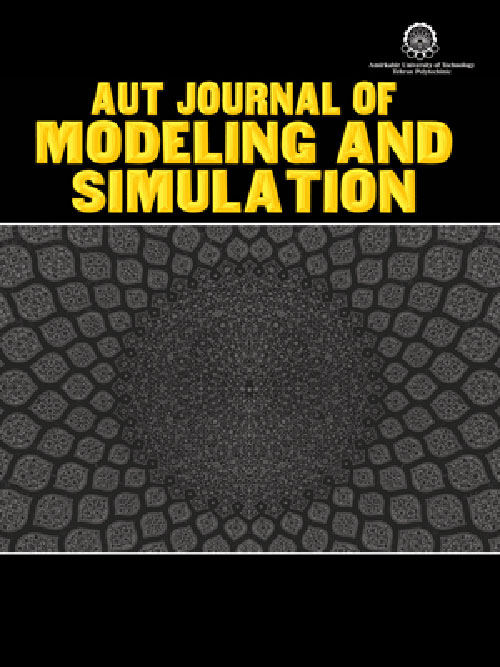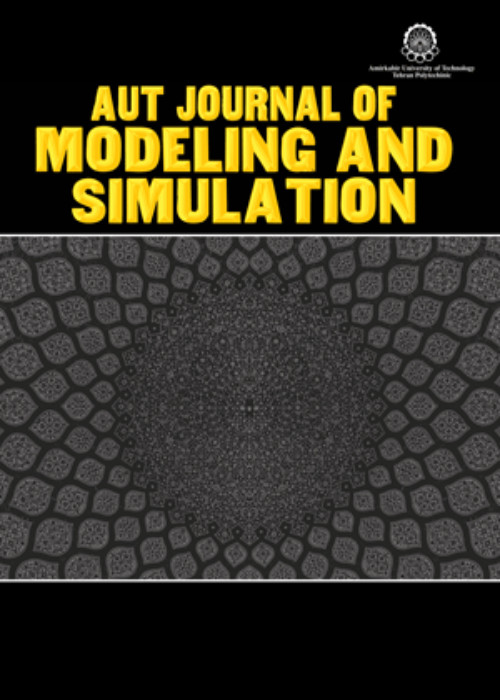فهرست مطالب

Journal of Modeling and Simulation
Volume:53 Issue: 1, Winter-Spring 2021
- تاریخ انتشار: 1400/08/15
- تعداد عناوین: 6
-
-
Page 1
The dynamic physical environment and geometric architecture required for tissue engineering can be achieved by combining tissue engineering scaffold and biological reactors. These bioreactors are used to perform mechanical stimulation on cells to create tissue. These cells are planted on the surface of the scaffold. In this system, the amount and distribution of mechanical stimulation applied to cells depend on the scaffold's microstructure. The geometry of the designed scaffold depends on two independent parameters. By changing these independent parameters, three scaffolds with different porosity are created. A flow rate of 0.05 ml/min has been used to perfuse the bioreactor. Simulations performed under steady-state conditions using continuity and Navier-Stokes equations. Based on the results, there was an increase in flow within the scaffold with the lowest porosity up to 10 times. The maximum wall shear stress and flow velocity were observed in the scaffold with the lowest porosity. The maximum wall shear stress on the scaffold with the highest porosity was 4.95 e-7 kPa. According to the findings, in order to apply the appropriate shear stress on cells and maintain a uniform pressure gradient across scaffold, porosity can be increased to some extent that does not damage the ideal surface area to volume ratio.
Keywords: Tissue engineering, Scaffold, bioreactor, wall shear stress, Pressure drop -
Page 2
Microneedles are a type of micron-sized needles that have been considered in recent years in various fields including drug release and rejuvenation. Simulation of penetration process of the microneedle into the skin is useful for examining the strength of the microneedle and its effect on the skin during penetration. In this study, penetration of the microneedles into the skin was simulated using finite element method. The skin is assumed to be in two layers and the Ogden model is applied to each of them. The path of microneedle penetration into the skin is predicted by cohesive elements. The results show that at a constant velocity of 0.36 mm/s in order for penetrating the epidermis only 0.5 s and penetrating the dermis only 2.5 s is needed. By decreasing the tip diameter of the microneedle, the reaction force applied to the microneedle decreased while the maximum stress in the skin also increased. As a result, it is recommended to use a conical model to design the microneedle. When the microneedle speed increases, the reaction force on the microneedle increases exponentially but these changes are more noticeable at high speeds. This simulation can be useful for medical biopsy sampling, drug release systems as well as stress assessment in rejuvenation.
Keywords: Microneedle, Skin, Computational Simulation, Finite Element Method, Cohesive element -
Page 3
Nowadays, biomechanical methods are useful to identify the cause and treating of diseases. One of these diseases is the cerebral aneurysm. This disease starts by the inflation of artery wall and then by rupturing, it leads to intracranial hemorrhage. Therefore, it leads to morbidity or even it is the cause of the mortality for many patients. For this reasons, it is important to anticipate the emersion, growth and the rupture of a cerebral aneurysm. Computational fluid dynamics (CFD) and 2-way fluid-structure interaction (FSI) are common methods for interrogation the rupture of aneurysms and evaluating the effective hemodynamic parameters. In this study, they were employed to obtain appropriate information of a cerebral aneurysm. A patient-specific giant aneurysm was chosen in the internal carotid artery (ICA). Mooney-Rivlin parameters were used for the solid part and a non-Newtonian Carreu model was employed in the fluid part. Important hemodynamic parameters such as wall shear stress (WSS), time average wall shear stress (TAWSS), spatial average wall shear stress (SAWSS), oscillatory shear index (OSI), and relative residence time (RRT) were discussed. In addition, these methods were then compared and the number of cycles assessed to determine the accuracy of the solutions. Both methods illustrate a similar location for the risk of a rupture related to these hemodynamic parameters but with different quantities. The novelty of this works lies at the feasibility of using the FSI and CFD methods to show the cost function in the future clinical decision-making.
Keywords: 2-way fluid structure interactions (FSI), Computational fluid dynamics (CFD), Hemodynamic parameters, Wall shear stress (WSS), Relative residence time (RRT) -
Page 4
In this paper, an in-pipe inspection robot is designed and modelled with a manipulator in order to provide the manipulation ability. In pipe robots are necessary machines toward periodical inspection of the inner environments of the pipe in where human is not able to enter. However, most of such robots are limited to perform inspecting operations. there are a lot of cases in where we need to perform an repairing task inside the pipe. In order to design an in-pipe inspection robot which is able to perform an operational task within the pipes, the robot is redesigned by adding a two-linkage serial manipulator with two extra DOFs on the main body of the moving robot. In this way, the robot will be a system with three degrees of freedom. The robot’s kinematic and dynamic models are obtained using Denavit-Hartenberg convention and Euler-Lagrange relations, respectively. Also, the system is controlled using inverse dynamics. Formulas verification, as well as analysis of its results, has been done by MATLAB software. The correctness of modelling and efficiency of the proposed manipulation is investigated by comparing actual and desired paths. The proposed mechanism is efficient regarding ease and cost reduction. It will be seen that the mechanism is fully applicable for this robot to cover the operational tasks.
Keywords: In-Pipe Inspection Robot, Repairing Robot, Kinematic, Dynamic Modelling, Manipulator -
Page 5
A literature review of the Tilt Rotor/Tilt Wing (TR/TW) Unmanned Aerial Vehicles (UAVs) is presented in this paper from the flight mechanics and control points of view. Firstly, the advantages as well as the challenges of the TR/TW UAVs are studied, from the design, aerodynamic, flight dynamic and control viewpoints. Next, a chronicle of the most important researches conducted about the TR/TW UAVs is reported. Then, these TR/TW UAVs are categorized based on the overall configurations, rotor arrangements, engine/rotor positions, and engine/rotor types. Next, a comprehensive flight dynamic modeling of the TR/TW aircraft is introduced that may provide a complete and consistent set of the dynamic equations for any type of the TR/TW regardless of the configurations and rotor arrangements. Afterwards, a survey is carried out about the trim and stability of the TR/TW within the hover and transition phases of flight. Finally, different control methods and control strategies utilized for the attitude and altitude control of the TR/TW UAVs are categorized based on their pros and cons. Since this paper covers the flight mechanics and control of the TR/TW UAVs, it may assist designers in making decisions about the most critical aspects of a new design based on the previous studies.
Keywords: Tilt Rotor, Tilt Wing, Unmanned Aerial Vehicles, Flight mechanics, Control -
Page 6
A novel smart vaccination method is proposed in this paper to distribute a limited number of vaccines among the people of a large community, such as a country, consisting of smaller communities like cities or provinces. The proposed method is comprised of two phases; A vaccine allocation phase and a targeted vaccination phase. In the first phase, the available vaccines are allocated to the communities based on demographics and the effectiveness of each type of vaccine. In the second phase, each community is modelled as a contact graph, and the vaccines available to the community are administered to the individuals whose vaccination has the greatest impact on breaking the chain of transmission. As a result of utilizing the Node2Vec graph embedding algorithm, the complexity of the proposed method increases linearly with the number of people in the community, as opposed to common centrality based methods, the complexities of which increase with the square or cube of the number of individuals. Furthermore, the proposed method can distribute multiple types of vaccines with different probabilities of effectiveness. The performance of the proposed method is comparable to the common centrality based vaccination methods, while its complexity is lower. The results of the simulation show a 20% decrease in the peak number of infected individuals.
Keywords: Smart Vaccination, Vaccine allocation, Targeted Vaccination, Node2Vec, SIR Model


